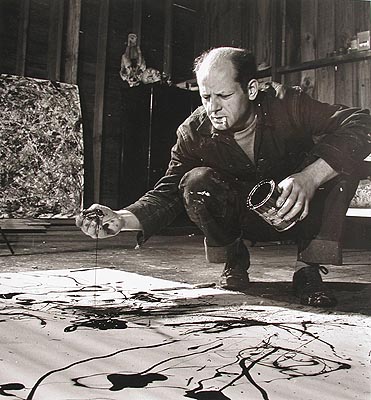“Artists Make Movies” at Pollock Krasner House

This year, the Pollock Krasner House has been celebrating Jackson Pollock’s 100th birthday in innovative, interesting and insightful ways under the guidance of Helen Harrison. The annual “Artists Make Movies: Motion and Emotion” series will also pay homage to Pollock, screening works that have a thematic connection to the famous abstract impressionist. (Most of the films’ directors knew the artist.)
The idea of “emotion” has always been relevant to Abstract Expressionism as has the concept of “motion,” which suits Pollock, who is often described as an “action painter.” Thus, the films are full of passion derived from the directors’ commitment to their subjects and themes; technically speaking, movement is also pervasive, evoked by editing and camera fluidity.
The first screening is of the work of Hans Namuth, himself an internationally known photographer, and Paul Falkenberg. Jackson Pollock was shot on location at Pollock’s Springs residence, but what’s important is Namuth’s evocation of Pollock’s process, which is conveyed by a worms-eye-view. It’s not only an unusual perspective, but it sticks in our minds: we know that it’s the one image which defines Pollock’s vision. Pollock’s own narration also adds to this special vision.
Accompanying the film is another work, the Oscar-winning Day of the Painter by Robert Davis, a satire on both Namuth’s movie and Pollock’s process. It shows an artist painting abstract images, cutting up large canvases and selling them separately. We wonder if Davis believes that Pollock’s works were nothing more than cookie-cutter perfect.
The series also includes never-before-shown films by Sag Harbor artist Val Telberg, who, as a famous photographer, created extraordinary photomontages. These motion pictures continued his arresting superimpositions and outstanding compositions that Telberg developed in his still imagery, including the documentary about Haitian dancers, Montage Haitien. The other movie, Widow’s Walk, celebrates the choreography of his wife, dancer Lelia Katayen, a piece that was shot on the beach in Amagansett.
Local resident Rick Telberg, the filmmaker’s son, will be at the screening to contribute comments and anecdotes. According to him, playmates couldn’t visit his house because of his parent’s unusual profession. He can’t help but add, however, that his mother and father had “immense respect for each other’s work, cooperating greatly with each other when doing films. If my father needed a special camera angle, my mother choreographed it.”
Maya Deren’s At Land will also be shown with Telberg’s film, a work that shares many similarities with Widow’s Walk: both were shot in Amagansett, using the beach as a metaphor. Moreover, Deren and Telberg experimented with Expressionism and Surrealism, avant-garde approaches that have played a tremendous part in the evolution of cinema and art.
Works of Calder, a movie by another local artist and filmmaker, Herbert Matter, will be screened on a subsequent Friday. This documentary, featuring Calder’s mobiles created in his Connecticut workshop, is also an ode to Montauk, where early segments were shot. John Cage composed the music, and Pollock was the production assistant.
The last screening in the series is an homage as well, this time to photographer, painter and pioneer of direct animation, Len Lye. Combining dance, ritual, music and art, Lye owes much of his inspiration to his friendship with Pollock. Most importantly, such connections helped establish Abstract Expressionism in “underground” films.
“Artists Make Movies: Motion and Emotion” will be presented each Friday at 7 p.m. in September at the Pollock Krasner House (830 Fireplace Road, East Hampton). Call 631-324-4929 or go to the website (pkhouse.org) for information and schedule.



